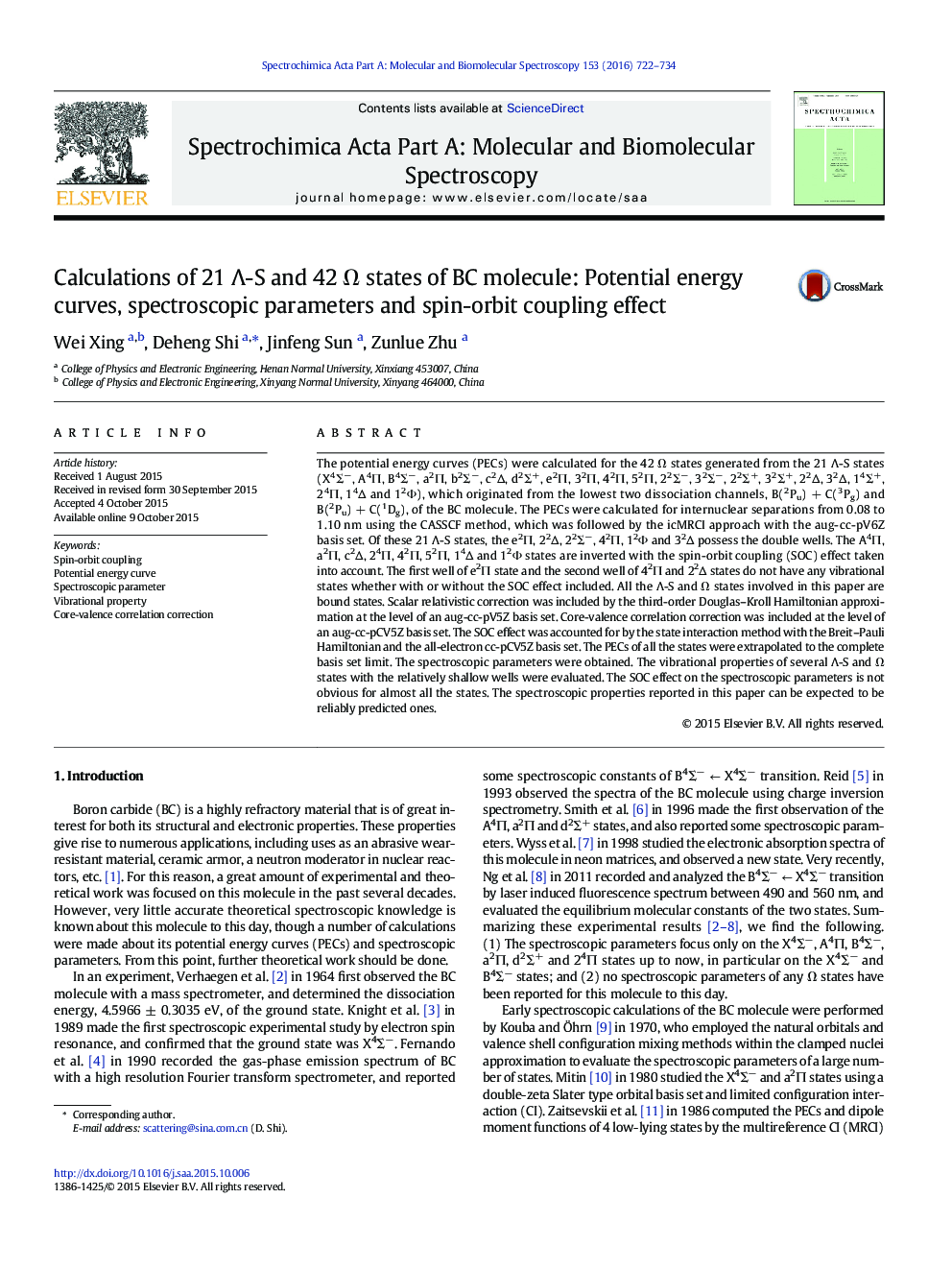| Article ID | Journal | Published Year | Pages | File Type |
|---|---|---|---|---|
| 1228787 | Spectrochimica Acta Part A: Molecular and Biomolecular Spectroscopy | 2016 | 13 Pages |
•Effect of core-valence correlation and scalar relativistic corrections are included.•PECs are extrapolated to the CBS limit.•Spectroscopic parameters of 21 Λ-S states and 42 Ω states are obtained.•SOC effect on the spectroscopic parameters is discussed.•Vibrational properties of some states are evaluated.
The potential energy curves (PECs) were calculated for the 42 Ω states generated from the 21 Λ-S states (X4Σ−, A4Π, B4Σ−, a2Π, b2Σ−, c2Δ, d2Σ+, e2Π, 32Π, 42Π, 52Π, 22Σ−, 32Σ−, 22Σ+, 32Σ+, 22Δ, 32Δ, 14Σ+, 24Π, 14Δ and 12Φ), which originated from the lowest two dissociation channels, B(2Pu) + C(3Pg) and B(2Pu) + C(1Dg), of the BC molecule. The PECs were calculated for internuclear separations from 0.08 to 1.10 nm using the CASSCF method, which was followed by the icMRCI approach with the aug-cc-pV6Z basis set. Of these 21 Λ-S states, the e2Π, 22Δ, 22Σ−, 42Π, 12Φ and 32Δ possess the double wells. The A4Π, a2Π, c2Δ, 24Π, 42Π, 52Π, 14Δ and 12Φ states are inverted with the spin-orbit coupling (SOC) effect taken into account. The first well of e2Π state and the second well of 42Π and 22Δ states do not have any vibrational states whether with or without the SOC effect included. All the Λ-S and Ω states involved in this paper are bound states. Scalar relativistic correction was included by the third-order Douglas–Kroll Hamiltonian approximation at the level of an aug-cc-pV5Z basis set. Core-valence correlation correction was included at the level of an aug-cc-pCV5Z basis set. The SOC effect was accounted for by the state interaction method with the Breit–Pauli Hamiltonian and the all-electron cc-pCV5Z basis set. The PECs of all the states were extrapolated to the complete basis set limit. The spectroscopic parameters were obtained. The vibrational properties of several Λ-S and Ω states with the relatively shallow wells were evaluated. The SOC effect on the spectroscopic parameters is not obvious for almost all the states. The spectroscopic properties reported in this paper can be expected to be reliably predicted ones.
Graphical abstractThe PECs of 21 Λ-S and 42 Ω states are calculated using the CASSCF method followed by the icMRCI approach. The SOC effect, core-valence correlation and scalar relativistic corrections are included at the level of icMRCI theory. (1) The A4Π, a2Π, 42Π, 52Π, c2Δ, 24Π, 14Δ and 12Φ states are found to be inverted with the SOC effect taken into account. (2) The e2Π, 22Δ, 22Σ−, 42Π, 12Φ and 32Δ possess the double well, whereas the first well of e2Π state and the second wells of 22Δ and 42Π states do not possess any vibrational states. (3) Besides the e2Π, 22Δ, 22Σ−, 42Π, 12Φ and 32Δ states, the B4Σ, 24Π, 32Π, 52Π, 32Σ− and 32Σ+ states also possess the barriers, and the potential energies of some barriers are obviously larger than those at their respective dissociation limits. (4) The avoided crossings can be clearly seen between the e2Π and 32Π states, and between the 42Π and 52Π states. The spectroscopic parameters of 21 Λ-S states and 42 Ω states are determined, and agree well with available measurements. The vibrational properties of several Λ-S and Ω states are evaluated. The SOC effect is small for almost all the states. The spectroscopic parameters reported in this paper can be expected to be reliably predicted ones.Figure optionsDownload full-size imageDownload as PowerPoint slide
